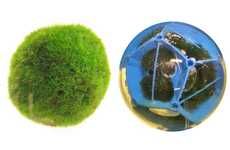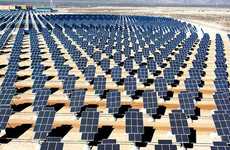
Development on MIT's Legendary Artificial Leaf is Finally Complete
Omar Yusuf — October 14, 2011 — Eco
References: sciencemag.org & treehugger
Although there have certainly been murmurs about this technology for months (if not years), who would have thought that MIT researchers would actually perfect the artificial leaf? I certainly had doubts.
For better or worse, technology seeks to continue replacing nature, even at the most fundamental levels. The artificial leaf is another step in that direction, not only heralding breakthroughs in clean air production and sustainability, but expanding the human understanding of the world. Using abundantly available materials like silicon and nickel, the leaf reproduces the photosynthetic process of oxygen from water and carbon dioxide. Lead professor Daniel Nocera explains his prophecy of a world where apartment flats are dotted with artificial leaves, producing clean air and usable energy which naturally occurs during the chemical process.
For better or worse, technology seeks to continue replacing nature, even at the most fundamental levels. The artificial leaf is another step in that direction, not only heralding breakthroughs in clean air production and sustainability, but expanding the human understanding of the world. Using abundantly available materials like silicon and nickel, the leaf reproduces the photosynthetic process of oxygen from water and carbon dioxide. Lead professor Daniel Nocera explains his prophecy of a world where apartment flats are dotted with artificial leaves, producing clean air and usable energy which naturally occurs during the chemical process.
Trend Themes
1. Clean Air Production - The development of synthetic photosynthesis opens up opportunities for disruptive innovation in clean air production technologies.
2. Sustainability - The completion of MIT's artificial leaf indicates disruptive innovation possibilities in sustainable energy generation and resource conservation.
3. Advanced Materials - The use of abundantly available materials like silicon and nickel in synthetic photosynthesis paves the way for disruptive innovation in advanced materials for energy production.
Industry Implications
1. Environmental Technology - The synthetic photosynthesis trend presents disruptive innovation opportunities in the environmental technology industry for developing novel air purification solutions.
2. Renewable Energy - The advancements in artificial leaf technology create disruptive innovation opportunities in the renewable energy industry, specifically for enhancing sustainable energy generation methods.
3. Materials Science - The development of synthetic photosynthesis in using abundant materials like silicon and nickel signifies disruptive innovation prospects in the materials science industry, particularly for exploring novel energy conversion materials.
1.8
Score
Popularity
Activity
Freshness























